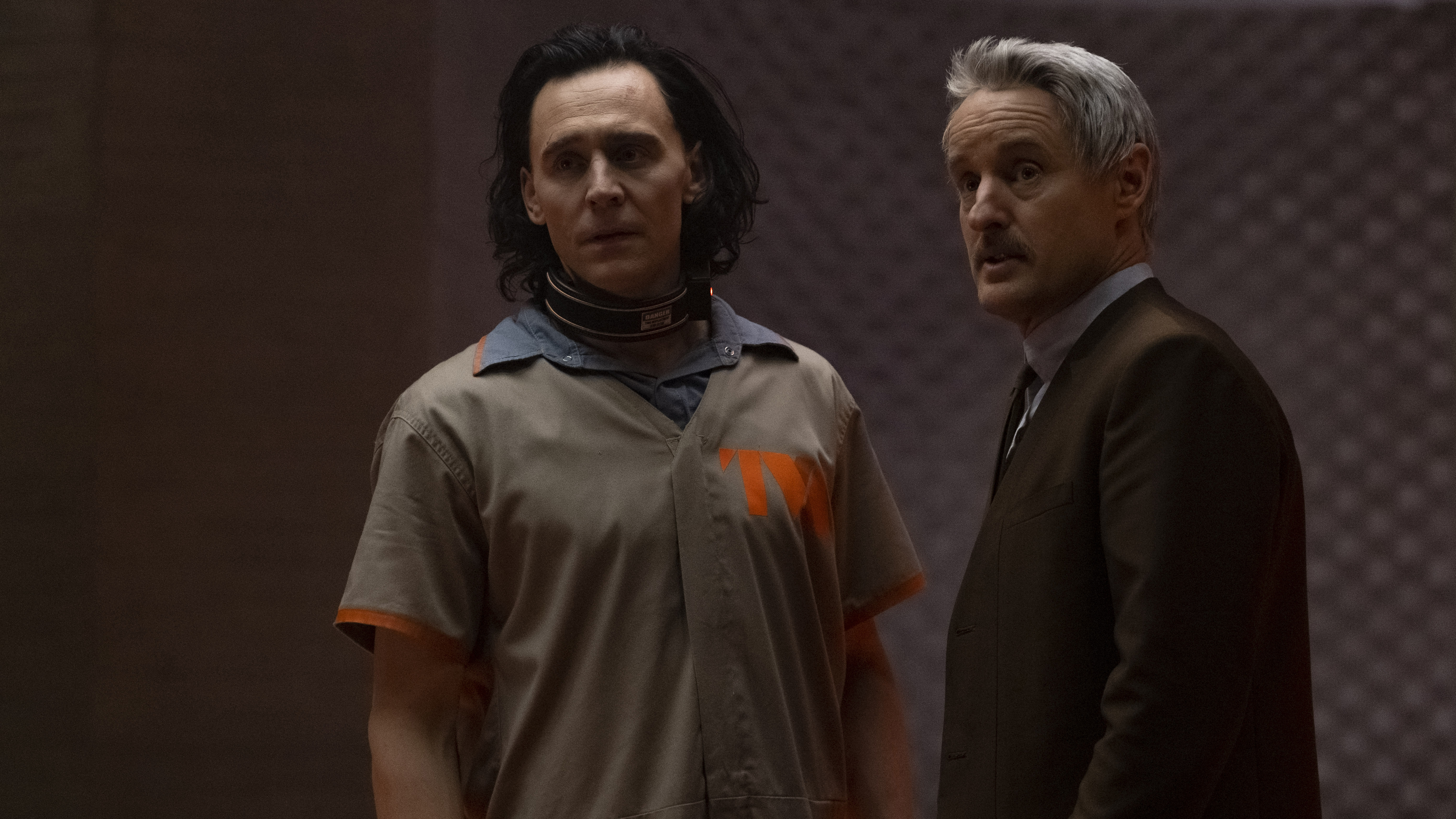'Loki' and the "Man Behind the Curtain" legacy
It is all going a little bit 'The Wizard of Oz,' in the Disney Plus series.

This post contains spoilers for Loki.
Check out our last review here.
"What happened to finding the man behind the curtain?” Sylvie (Sophia Di Martino) asks Judge Ravonna Renslayer (Gugu Mbatha-Raw) in the penultimate episode of Loki moments before she prunes herself into the Void in which Loki (Tom Hiddleston) has been sent. Taking down the Time Variance Authority has been Sylvie’s goal since she was a young girl and this doesn’t change after the big Time Keepers reveal. The informative video that Loki watched upon his arrival to the midcentury-inspired TVA is fiction masquerading as law. The Time Keepers are actually robots, but there must be someone pulling their strings and Sylvie is intent on finding out who is behind this entire operation. “Journey into Mystery” ends with the two variants heading into the great unknown that is bathed in green light. This shade is Loki’s signature (and part of the enchantment), but the link to Emerald City is hard to ignore and The Wizard of Oz’s influence is stamped all over this storyline.
Based on L. Frank Baum’s seminal 1900 novel The Great Wizard of Oz, MGM’s 1939 landmark Technicolor release is ingrained in pop culture. Whether it is Judy Garland’s legendary performance of “Somewhere Over the Rainbow,” costume designer Adrian’s ruby red slipper and gingham dress contribution, or pervasive phrases, it is hard to imagine a world without this contribution. One such line comes courtesy of the big Emerald City reveal when Dorothy’s dog Toto unmasks the identity of the disembodied voice with one tug of the drapery. Yes, the man behind the curtain is a regular flesh and blood human by the name of Oscar Zoroaster Phadrig Isaac Norman Henkle Emmannuel Ambroise Diggs — quite the mouthful. “Oh, no, my dear; I'm really a very good man, but I'm a very bad Wizard, I must admit,” he tells Dorothy when the jig is up. This moment also occurs in Baum’s novel and the idea that a humbug (someone acting in a deceptive manner) is masquerading as a powerful figure is a popular story trope, which often causes characters to question authority and/or belief systems.
“Pay no attention to that man behind the curtain,” he exclaims when Toto reveals his identity and attempts to carry on the ruse before realizing it is futile. When Sylvie uses this term, it isn’t even necessarily saying that during her travels she has had time to catch this classic piece of American cinema, rather, the phrase is ubiquitous outside of its origin. As a narrative tool, this enduring legacy comes from its simplicity and ability to apply it to any scenario with a mysterious figure who is in power. In The Wizard of Oz, he is seen as the answer to Dorothy’s quest to return to Kansas and they believe he can bestow the Tin Man, Cowardly Lion, and Scarecrow with the items they desire (a heart, courage, and a brain). He is a god-like figure and the push-pull between blind faith and a discovery like this can be devastating.
Loki takes two different approaches to the shattering of an illusion; B-15 (Wunmi Mosaku) and Mobius (Owen Wilson) turning their back on the institution they have been serving for what feels like a lifetime, whereas Renslayer sees no reason to dig any deeper into the power structure at play. The latter is the type of figure who would happily keep up the lie, whereas B-15 and Mobius are incapable of maintaining the deception. They actively choose to aid Sylvie and Loki in any way possible, and the knowledge of a previous life is a wake-up call. Renslayer convinces Sylvie she is on her side and it is clear the Judge is just as adept at manipulation as the tricksters she has been hunting. Well, not quite as good as Sylvie figures out that her goal is to keep the sacred timeline in order, and doesn’t want to know the identity of the string-puller. She is paying no attention to the man behind the curtain — or is protecting this figure.

The penultimate episode of Loki has drawn comparisons to Lost from its version of a smoke monster (hello, Alioth!) protecting this location to the Wizard of Oz illusions. John Locke (Terry O’Quinn) becomes a man of faith after he regains the ability to walk when Flight 815 crashed on this mysterious island. He doesn’t need to find the equivalent of the wizard to get his deepest wish, but he is obsessed with unlocking this cloaked location’s many secrets. The introduction of Ben Linus (Michael Emerson) as the antagonist in Season 2 is one of the show’s best twists and this is character is impossible to trust. “The Man Behind the Curtain” takes place in the third season and unravels some of the Dharma Initiative mysteries, including how Ben came to be on the island — one of his many lies is that he was born there. “We all answer to someone, John,” he explains about the elusive Jacob. But John has a theory and utilizes pop culture to aid his point:
“I think there is no Jacob. I think your people are idiots if they think you take orders from someone else. You are the man behind the curtain, the Wizard of Oz. And you’re a liar.”
The latest updates, reviews and unmissable series to watch and more!
Rather than revealing a figure in an opulent castle, they venture deep into the jungle and a sparsely decorated rickety old cabin. What feels like another Ben trick takes a turn for the creepy when Locke hears a different voice say “Help me” and then objects are thrown around. Locke insists this is all part of a show Ben has put on and doubles down on the fraudulent claims. In some respects, the Island is similar to Loki’s Void and TVA locations, as there are fervent believers, skeptics, and those who want to return to where they came from.

Those perpetuating the fiction often do so under the guise of maintaining order, whether it is the TVA or Ben Linus. Snowpiercer’s first episode reveals the so-called inventor of the life-saving locomotive Mr. Wilford isn’t even on board, and Melanie Cavill (Jennifer Connelly) has spent the last seven years masquerading as the enigmatic figure. Her reasoning is to ensure the power structure stays in place and the delicate balance will fall apart if this was to come out — it does and it does. This is another man behind the curtain scenario and is put to the test further when the unscrupulous leader turns up alive at the end of the first season. Sometimes the wizard does exist and he is terrifying.
“I think the person we’re after is beyond the Void at the end of time,” Sylvie tells Loki about their current location. As the curtain peels back in the final moments of “Journey into Mystery,” a castle can be seen in the distance. Who resides in such an audacious and isolated location? “The dogma states that the end of time is still being written, that the Time Keepers are transforming it into utopia,” Renslayer explains earlier in the episode — but much like Ben Linus it is impossible to believe anything she says. What the series is gearing up for is another man behind the curtain reveal and there are a number of theories as to who is controlling the TVA (including a Loki variant).
The first episode features a free will debate — Loki is convinced he makes his own path — and this man behind the curtain narrative tool is an extension of this conversation. The latter is both effective and enduring because of how it makes characters (and the audience) question belief systems and the human drive. No matter the identity, it will be impossible for Loki to ignore that man behind the curtain.
Emma Fraser spends most of her time writing about TV, fashion, and costume design; Dana Scully is the reason she loves a pantsuit. Words can also be found at Vulture, Elle, Primetimer, Collider, Little White Lies, Observer, and Girls on Tops. Emma has a Master’s in Film and Television, started a (defunct) blog that mainly focused on Mad Men in 2010, and has been getting paid to write about TV since 2015. It goes back way further as she got her big start making observations in her diary about My So-Called Life’s Angela Chase (and her style) at 14.


